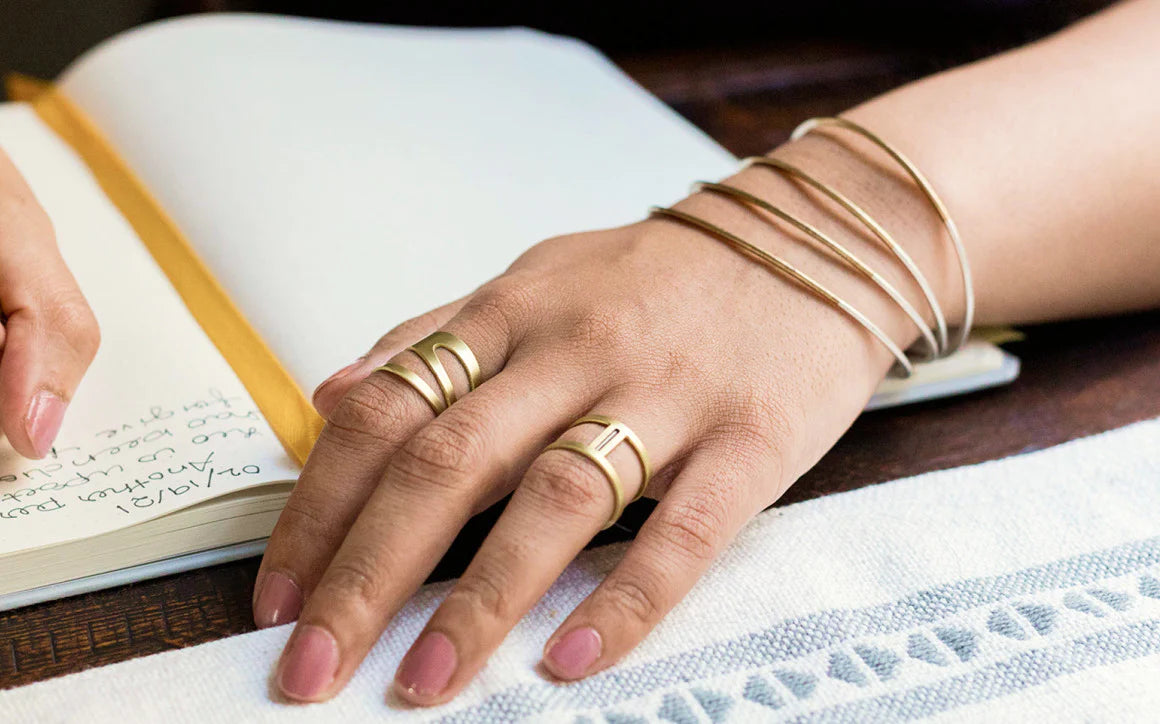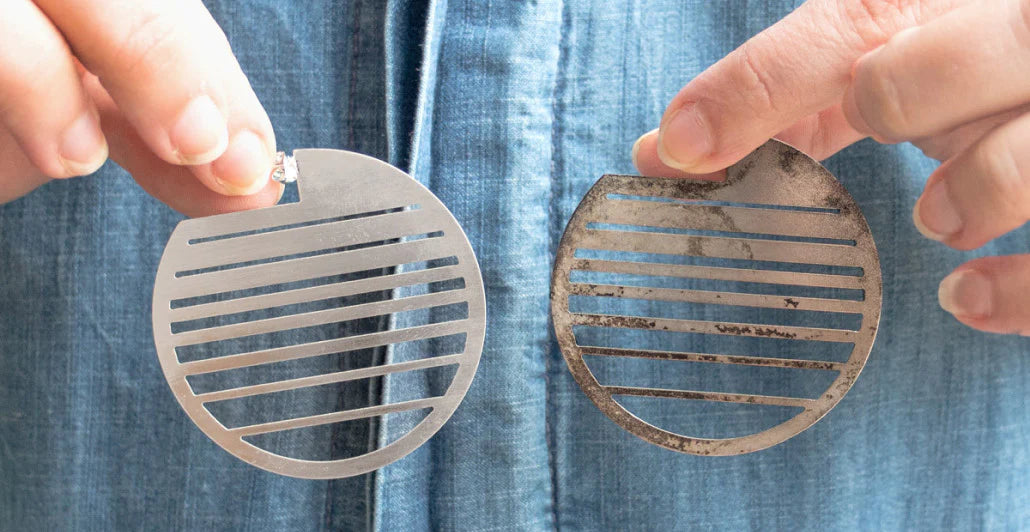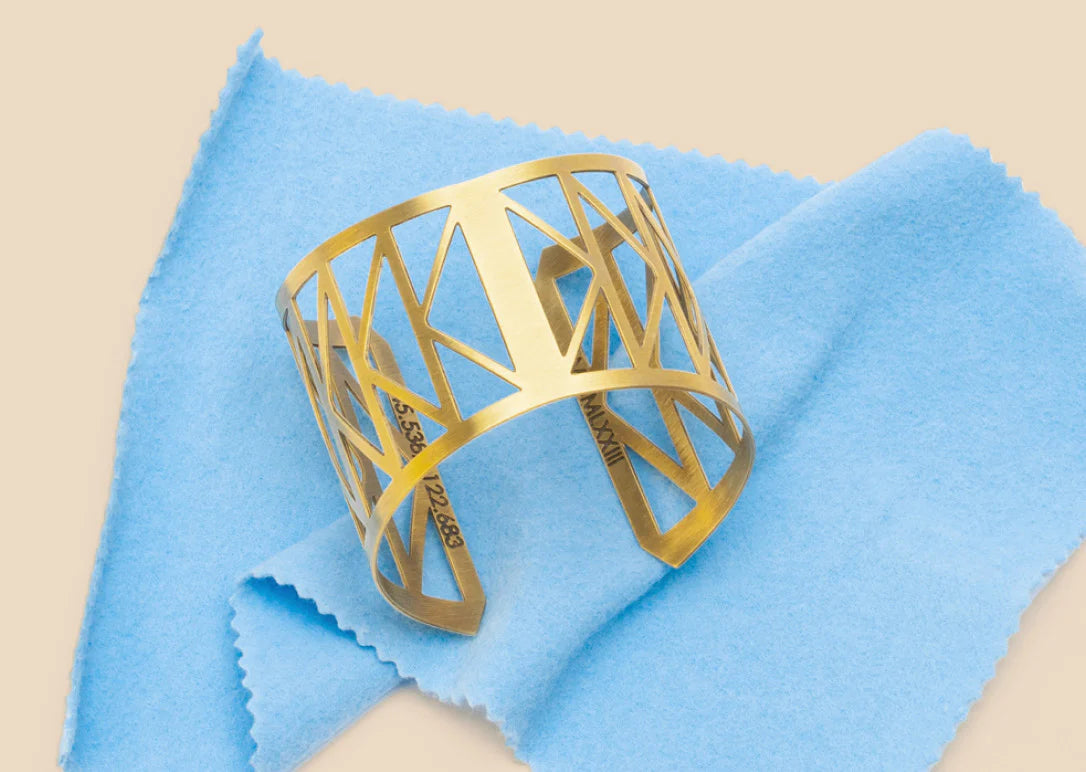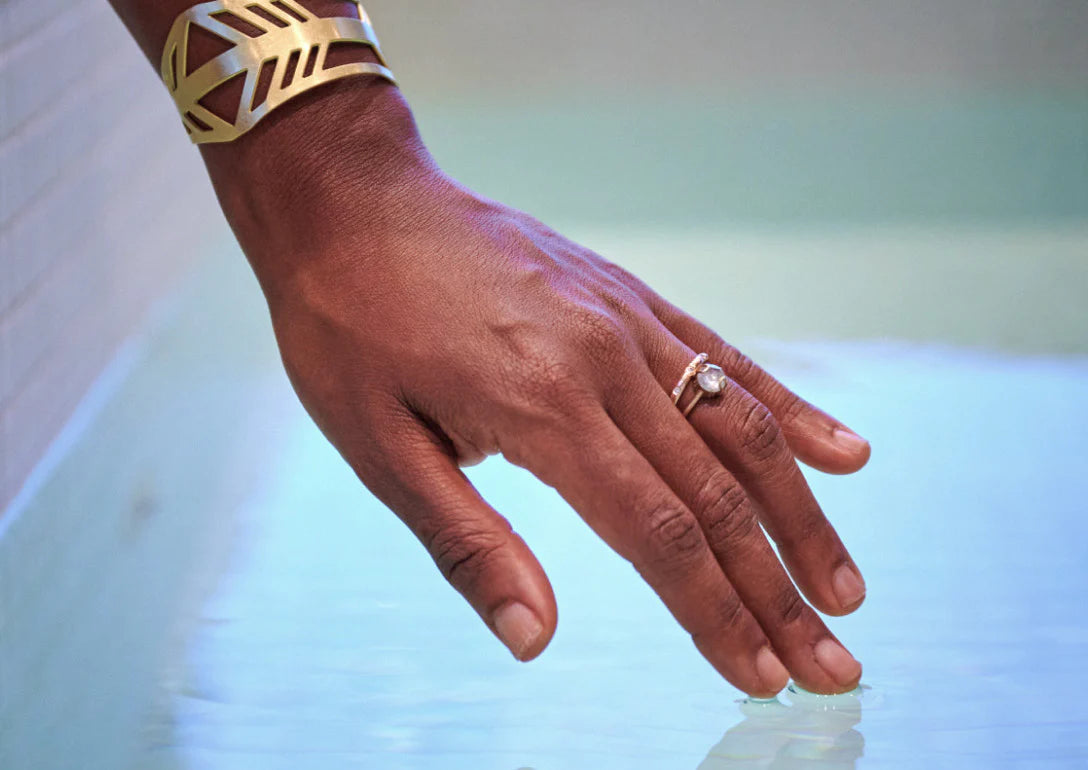What's The Difference?

Fashion Jewelry
Our fashion jewelry is made of brass, bronze, sterling & plated silver and semi-precious gemstones, like turquoise.

Fine Jewelry
Our fine jewelry is made of 14K gold, platinum, palladium, or includes diamonds and other precious gemstones.
Your Jewelry's Enemies
No matter how careful you are, all jewelry will age over time. Here's some of the most common sources of tarnish and other wear on jewelry.
Exposure to natural elements (like air, water, and humidity) can cause your jewelry to tarnish. Only 24K pure gold is safe from Mother Nature’s elements.
Chemicals from bath + body products, perfumes, and chemically-treated water (like hot tubs) can permanently damage your jewelry.
Strenous activities (exercising, gardening, pot scrubbing, etc.) can cause metals to bend or wear. Our natural chemistry can cause different reactions with metals.

Wait, What's Tarnish?
Tarnish occurs naturally. When certain metals are exposed to air and moisture, the natural chemical reaction creates a layer of tarnish.
Why and how does this happen? Three main reasons:
- Rubbing, knocking, or pressing against things (obvious things like walls, doors, etc., but also other jewelry, clothing, bike handlebars, dumbbell bars, even bedsheets… basically anything you hold or brush up against)
- Exposure to natural elements like the air, moisture, skin/sweat/body chemistry. Read more about tarnish.
- Exposure to other chemicals from bath/body products, pools/hot-tubs, even off-gassing in manufactured products.
Damage can include:
- Bent/deformed metal
- Deep metal dents or scratches
- Stone cracks, scratches, splinters, chips
- Weakened prongs or loose stones
- Stretched or snapped chain
Humidity, chemicals, hairspray, and perfume can be your jewelry's archenemies, so spray first, accessorize second, and keep your jewels out of the bathroom, shower, kitchen sink, hot tub, sprinkler, monsoon. All of this applies whether you’re wearing or storing your jewelry. We also recommend removing jewelry before working out or getting sweaty, as sweat from different body chemistries can cause different reactions with metal. Chlorine and other pool/hot tub chemicals can be particularly damaging to certain metals and may permanently ruin your jewelry.
A few activities we’ve seen end poorly for jewelry:
- Sleeping in jewelry - Obviously an issue for earring and necklaces, but also for rings and bracelets too: the constant friction between sheets and metal as one sleeps can cause rings to wear down over time. They can also get caught on bedding without one realizing it.
- Stacking jewelry - Don’t get us wrong, we’re all about a good stack. But you should know that stacked rings and bracelets are more likely to rub against each other, which can affect the finish of these pieces over time.
- Climbing, mountain biking, cycling, spin workouts, weight lifting - activities which put strain on your hands and can cause metal to bend or wear down. Earrings and necklaces may get caught or bent, metal that’s sweated on can react to body chemistry.
- Hot tubbing, pools, hot springs, cleaning house with any sort of cleaning product (natural or non) - you just never know what’s in cleaning supplies or chemically treated water and how it will react to your jewelry.
- Difficult hikes, saunas, strenuous physical exertion and activity - metal that’s sweated on can react to body chemistry and of course strenuous activity poses a risk of bends and snags.
- Washing dishes or your hands - be especially careful when wearing rings with oxidized areas, soft stones, and painted or epoxied components, but even rings without these characteristics can be affected by water or different soaps. Sometimes this is preferred; your rings get cleaned. Over time, it can change the finish by burnishing away a more matte finish or adding tiny micro abrasions to high polished finishes.
- Gardening, beach activities, making things like ceramics - grit, sand, and other abrasives can damage stones and metal.
It’s not guaranteed that doing any of the above will cause harm to your jewelry, but it’s possible. The jewelry we make is made to last, but not indestructible. Basically, when in doubt, remove your jewelry. Be most careful with pieces that include inlay, fine chains, very thin wires and fibers.
Caring For Jewelry At Home
There are several things you can safely do from home to clean, remove tarnish/patina, detangle, and straighten out bends in your jewelry.

Polishing Cloth
Don’t be afraid to put some oomph in it.

Mild Soap & Warm Water
Like a relaxing bath to your jewelry. Be sure to dry thoroughly.

Detangling & Straightening
We recommend placing necklaces on a flat surface to detangle. Flex those patience muscles!
|
For use on |
Not for use on |
Notes and How to |
|
|
Polishing cloths |
Sterling silver, gold, gold-filled, brass, bronze, copper, glass/mirrors, and more Pieces with a polished finish or where a polished finish is desired. |
Plated metal. Pieces with a matte or brushed finish - cloths may overshine these finishes. |
Simply rub the cloth on the material you’re hoping to clean or polish. Polishing cloths take a little elbow grease. Don’t be afraid to put some oomph into it. Cloth will turn black as it removes tarnish and can continue to be used even when it appears very dirty. In our shop, we basically use them until they're in tatters. If cloth stops polishing, it's time for a new cloth. Each cloth is impregnated with special chemical cleansing agents and non-scratching micro-abrasives and should not be washed. |
|
Warm water, mild soap, and a soft toothbrush or non-abrasive cloth |
Sterling silver, gold, gold-filled, brass, bronze, copper. Pieces with a matte finish. |
Pieces with a high polish finish - even the softest toothbrushes and cloths can leave micro abrasions which can dull jewelry with a high polish finish. Plated metal may also be damaged by soft toothbrushes. |
Let your piece soak in warm water and gentle soap for at least 15 minutes, then use a soft non-abrasive cloth (100% cotton or microfiber) and/or a soft toothbrush to gently wipe and clean metal and stones. Dry thoroughly. |
|
Windex and a soft, non-abrasive cloth |
Plated metal. Won’t hurt other types of metal, but the methods above will likely be more effective. |
Softer or porous stones. |
Apply a squirt of Windex to the metal. Use a soft, non-abrasive cloth (100% cotton or microfiber) to wipe clean. Plated metal is difficult to clean. Remember we’re here to help if you’ve got stubborn patina. |
General notes:
- None of the tips we’ve given here will damage your jewelry beyond repair, but clean your jewelry at your own risk. Take special care around fiber or leather components, and painted or epoxied areas of jewelry. These tips are meant to be safe for metal and most stones, not other materials.
- Cleaning is not equivalent to refinishing. In fact, some of these cleaning methods may result in a brighter or duller finish than your piece originally came with. Bring refinishing jobs to us.
- Do not attempt to clean chemically oxidized surfaces (darker metal parts).
- Do not use polishing cloths on plated metal as they can be damaged by the abrasiveness of the cloth.
- Don’t use chemical dips. We don't recommend it and we cannot be responsible for any damage caused by dip polishing your jewelry. We've seen chains become brittle and break after being dipped. Additionally, dip can react in unpredictable and sometimes unfortunate ways with oxidized, wax-sealed, and painted surfaces.
- Be careful with other home remedies you may find on the internet. Not all cleaning methods are safe for all materials. We don’t share cleaning methods that are safe for some materials and could damage others. When in doubt, get in touch with us first.
Repairs In Our Studio
When home remedies aren’t enough, we offer free repairs on our fashion jewelry and free cleanings on our fine jewelry in our Portland studio.
Snag a chain or bend a bridge cuff? We repair broken Betsy & Iya fashion jewelry for free with only a few limitations.
If you lost a single B&I earring, we would be happy to sell you a half-pair from our current collection! Fill out a half-pair form here.
We offer complimentary cleanings and inspections on B&I fine jewelry. After inspection, we can quote you for any repairs or maintenance needed.
We recommend bringing in your fine jewelry for cleaning and inspection every 6 months. This helps keep your piece in shape by catching small issues before they turn into big ones.
Our free repairs service applies only to Betsy & Iya fashion jewelry. Within this category, we also distinguish between repairs for breaks, and maintenance for wear & tear. Our free repair service is not meant to address normal wear and tear (like scuffs, stretching, or other signs of age that occur slowly over time) or take the place of regular maintenance (including removing tarnish and other things you can do at home).
These free repairs will not restore your jewelry to like new condition, but rather restore it to its condition just before it broke. We’re happy to help you keep your jewelry in like new condition (refinishing and polishing, or addressing other normal wear and tear issues, like straightening out bends), but we will charge a modest fee for these services. We reserve the right to limit free repairs on a case by case basis to prevent abuse of this service.
If your broken B&I jewelry has served you valiantly and it’s just time to say goodbye, be sure to check out Recast, our buy-back program, where we buy back your Betsy & Iya jewelry (even if it’s broken), clean it up, fix it, and resell it at a discount.
We don’t repair other designers’ jewelry or non-jewelry products we sell. If you bought it from us initially, we are happy to help connect you with the designer to facilitate the repair. Most of our other designers charge for repairs. Of course, if your product has broken due to a defect, we will work with you to make this right without charge. For jewelry you didn’t buy from us initially, we can refer you to a few places around town that might be able to help you with a repair.
Due to the high value and expert skill involved, fine jewelry does not qualify for free repairs beyond complimentary cleanings and inspections unless you purchased a Care Plan when you bought your fine jewelry from us. If you do not have a Care Plan, we will charge you a reasonable fee to cover labor and materials needed to repair fine jewelry you purchased from us.
Begin a Repair

We stand behind our jewelry and expect that with proper care, your Betsy & Iya jewelry will last for years to come.
Care FAQ
Not to fear – we almost definitely can repair it.
Added bonus: most fashion jewelry repairs are free! Yup, you read that right. We’ll repair Betsy & Iya fashion jewelry that you break for free. Why? Because we’d rather make you one pair of earrings you'll love and feel great in for years than 10 pairs you'll only kinda like. We do not work on jewelry we didn’t originally make or facilitate repairs for any jewelry we didn’t originally sell you. Additional limitations apply.
Read more about Fine jewelry repairs.
Begin a Repair
When we clean and inspect your jewelry, we will provide for your consideration and approval a quote listing any repairs or maintenance items we recommend be performed. We’ll wait for your approval before we perform any work on your fine jewelry and we’ll walk you through each line of it if you’d like.
If you have a Care Plan, maintenance is free for the original owner for the life of the piece (depending on which plan you purchased). Other terms and conditions may apply. See fine print in the Care Plan documentation you are provided with at the time of purchase.
If you didn’t purchase a Care Plan with your fine jewelry, we will charge you directly for materials and repair & maintenance services. Due to the complexity of our repair price list, we do not publish it, but our repair and maintenance fees are competitive with those of other jewelers.
Our free repairs service applies only to Betsy & Iya fashion jewelry. Within this category, we also distinguish between repairs for breaks, and maintenance for wear & tear. Our free repair service is not meant to address normal wear and tear (like scuffs, stretching, or other signs of age that occur slowly over time) or take the place of regular maintenance (including removing tarnish and other things you can do at home).
These free repairs will not restore your jewelry to like new condition, but rather restore it to its condition just before it broke. We’re happy to help you keep your jewelry in like new condition (refinishing and polishing, or addressing other normal wear and tear issues, like straightening out bends), but we will charge a modest fee for these services. We reserve the right to limit free repairs on a case by case basis to prevent abuse of this service.
If your broken B&I jewelry has served you valiantly and it’s just time to say goodbye, be sure to check out Recast, our buy-back program, where we buy back your Betsy & Iya jewelry (even if it’s broken), clean it up, fix it, and resell it at a discount.
We don’t repair other designers’ jewelry or non-jewelry products we sell. If you bought it from us initially, we are happy to help connect you with the designer to facilitate the repair. Most of our other designers charge for repairs. Of course, if your product has broken due to a defect, we will work with you to make this right without charge. For jewelry you didn’t buy from us initially, we can refer you to a few places around town that might be able to help you with a repair.
Due to the high value and expert skill involved, fine jewelry does not qualify for free repairs beyond complimentary cleanings and inspections unless you purchased a Care Plan when you bought your fine jewelry from us. If you do not have a Care Plan, we will charge you a reasonable fee to cover labor and materials needed to repair fine jewelry you purchased from us.
Begin a Repair
We use a wax-based sealant on some of our jewelry to slow the rate of tarnish and mitigate fingerprints, but we do not use electrolytically applied nanopolymers or polyurethane sealants that exist because we don’t like how these finishes age. We’ve seen metal begin to tarnish underneath the seals or seen the seals chip off or break down unevenly, which results in very difficult to clean, unattractive finish. Our raw metals will tarnish, but they can also be easily restored to their original luster. This workability is why we choose raw, unsealed metals.
Read about removing tarnish at home.
Read about tarnish in gold.
Why and how does this happen? Three main reasons:
- Rubbing, knocking, or pressing against things (obvious things like walls, doors, etc., but also other jewelry, clothing, bike handlebars, dumbbell bars, even bedsheets… basically anything you hold or brush up against)
- Exposure to natural elements like the air, moisture, skin/sweat/body chemistry. Read more about tarnish.
- Exposure to other chemicals from bath/body products, pools/hot-tubs, even off-gassing in manufactured products.
We offer the following warranties based on product type:
|
B&I Fine Jewelry |
B&I Fashion Jewelry |
inFiinite™ Permanent Jewelry |
Products made by others |
|
We offer a non-transferable one-year warranty on workmanship defects in our fine jewelry. We cannot warrant work performed by other jewelers (including resizing), and any such work will void our warranty. We also offer Lifetime Care Plans that cover a wide array of jewelry repairs (but not loss or theft) and nationwide access to repairs. These plans are offered with the purchase with our fine jewelry and backed by Jewelers Mutual. |
We do not offer a warranty on our fashion jewelry, but we do offer free repairs with some limitations. | Due to the inherent risk of stretching and snagging with permanent jewelry, we do not offer a warranty or free repairs on these products. If your inFiinite™ jewelry breaks, we may be able to reattach it for a small fee. | Warranties vary by maker. |
Outside of warranties, our general approach with customer service is that we want you to be happy with your purchase and we expect all products we sell to last a normal time with normal care by you. If there’s a product defect, we’ll work to make it right. If you damage a product or it ages with normal wear and tear, we’ll also work to make it right, but there may be reasonable charges for the latter and the definition of “make it right” may vary depending on which scenario we’re helping you with.
|
For use on |
Not for use on |
Notes and How to |
|
|
Polishing cloths |
Sterling silver, gold, gold-filled, brass, bronze, copper, glass/mirrors, and more Pieces with a polished finish or where a polished finish is desired. |
Plated metal. Pieces with a matte or brushed finish - cloths may overshine these finishes. |
Simply rub the cloth on the material you’re hoping to clean or polish. Polishing cloths take a little elbow grease. Don’t be afraid to put some oomph into it. Cloth will turn black as it removes tarnish and can continue to be used even when it appears very dirty. In our shop, we basically use them until they're in tatters. If cloth stops polishing, it's time for a new cloth. Each cloth is impregnated with special chemical cleansing agents and non-scratching micro-abrasives and should not be washed. |
|
Warm water, mild soap, and a soft toothbrush or non-abrasive cloth |
Sterling silver, gold, gold-filled, brass, bronze, copper. Pieces with a matte finish. |
Pieces with a high polish finish - even the softest toothbrushes and cloths can leave micro abrasions which can dull jewelry with a high polish finish. Plated metal may also be damaged by soft toothbrushes. |
Let your piece soak in warm water and gentle soap for at least 15 minutes, then use a soft non-abrasive cloth (100% cotton or microfiber) and/or a soft toothbrush to gently wipe and clean metal and stones. Dry thoroughly. |
|
Windex and a soft, non-abrasive cloth |
Plated metal. Won’t hurt other types of metal, but the methods above will likely be more effective. |
Softer or porous stones. |
Apply a squirt of Windex to the metal. Use a soft, non-abrasive cloth (100% cotton or microfiber) to wipe clean. Plated metal is difficult to clean. Remember we’re here to help if you’ve got stubborn patina. |
General notes:
- None of the tips we’ve given here will damage your jewelry beyond repair, but clean your jewelry at your own risk. Take special care around fiber or leather components, and painted or epoxied areas of jewelry. These tips are meant to be safe for metal and most stones, not other materials.
- Cleaning is not equivalent to refinishing. In fact, some of these cleaning methods may result in a brighter or duller finish than your piece originally came with. Bring refinishing jobs to us.
- Do not attempt to clean chemically oxidized surfaces (darker metal parts).
- Do not use polishing cloths on plated metal as they can be damaged by the abrasiveness of the cloth.
- Don’t use chemical dips. We don't recommend it and we cannot be responsible for any damage caused by dip polishing your jewelry. We've seen chains become brittle and break after being dipped. Additionally, dip can react in unpredictable and sometimes unfortunate ways with oxidized, wax-sealed, and painted surfaces.
- Be careful with other home remedies you may find on the internet. Not all cleaning methods are safe for all materials. We don’t share cleaning methods that are safe for some materials and could damage others. When in doubt, get in touch with us first.
|
Ok to try at home. |
Bring it to us. |
|
Removing some tarnish/patina |
Deep cleaning Removing stubborn tarnish/patina Intense detangling Refinishing - restoring that perfect matte or high polished finish the piece initially had Repair of damage Repair of long term wear and tear Read about our Repairs services. |
Damage can include:
- Bent/deformed metal
- Deep metal dents or scratches
- Stone cracks, scratches, splinters, chips
- Weakened prongs or loose stones
- Stretched or snapped chain
How to help keep your plated jewelry in good condition.
How to clean plated jewelry.
Humidity, chemicals, hairspray, and perfume can be your jewelry's archenemies, so spray first, accessorize second, and keep your jewels out of the bathroom, shower, kitchen sink, hot tub, sprinkler, monsoon. All of this applies whether you’re wearing or storing your jewelry. We also recommend removing jewelry before working out or getting sweaty, as sweat from different body chemistries can cause different reactions with metal. Chlorine and other pool/hot tub chemicals can be particularly damaging to certain metals and may permanently ruin your jewelry.
A few activities we’ve seen end poorly for jewelry:
- Sleeping in jewelry - Obviously an issue for earring and necklaces, but also for rings and bracelets too: the constant friction between sheets and metal as one sleeps can cause rings to wear down over time. They can also get caught on bedding without one realizing it.
- Stacking jewelry - Don’t get us wrong, we’re all about a good stack. But you should know that stacked rings and bracelets are more likely to rub against each other, which can affect the finish of these pieces over time.
- Climbing, mountain biking, cycling, spin workouts, weight lifting - activities which put strain on your hands and can cause metal to bend or wear down. Earrings and necklaces may get caught or bent, metal that’s sweated on can react to body chemistry.
- Hot tubbing, pools, hot springs, cleaning house with any sort of cleaning product (natural or non) - you just never know what’s in cleaning supplies or chemically treated water and how it will react to your jewelry.
- Difficult hikes, saunas, strenuous physical exertion and activity - metal that’s sweated on can react to body chemistry and of course strenuous activity poses a risk of bends and snags.
- Washing dishes or your hands - be especially careful when wearing rings with oxidized areas, soft stones, and painted or epoxied components, but even rings without these characteristics can be affected by water or different soaps. Sometimes this is preferred; your rings get cleaned. Over time, it can change the finish by burnishing away a more matte finish or adding tiny micro abrasions to high polished finishes.
- Gardening, beach activities, making things like ceramics - grit, sand, and other abrasives can damage stones and metal.
It’s not guaranteed that doing any of the above will cause harm to your jewelry, but it’s possible. The jewelry we make is made to last, but not indestructible. Basically, when in doubt, remove your jewelry. Be most careful with pieces that include inlay, fine chains, very thin wires and fibers.
Why? Pure gold (24k) does not tarnish or react with the air. But 24k gold isn’t used in jewelry applications due to its softness and malleability. To make it more suitable for jewelry applications, gold alloys are created with a mixture of other metals (like copper, silver, and others) which are added for color, durability, and/or desired physical or chemical performance. These other reactive metals are what causes tarnish in gold alloys; however, gold alloys will tarnish more slowly than brass, bronze, sterling silver, or copper. Gold alloys with higher gold content will tarnish slower than alloys with lower gold content, but again, our alloys will likely never show noticeable tarnish because it happens very slowly no matter the alloy.

